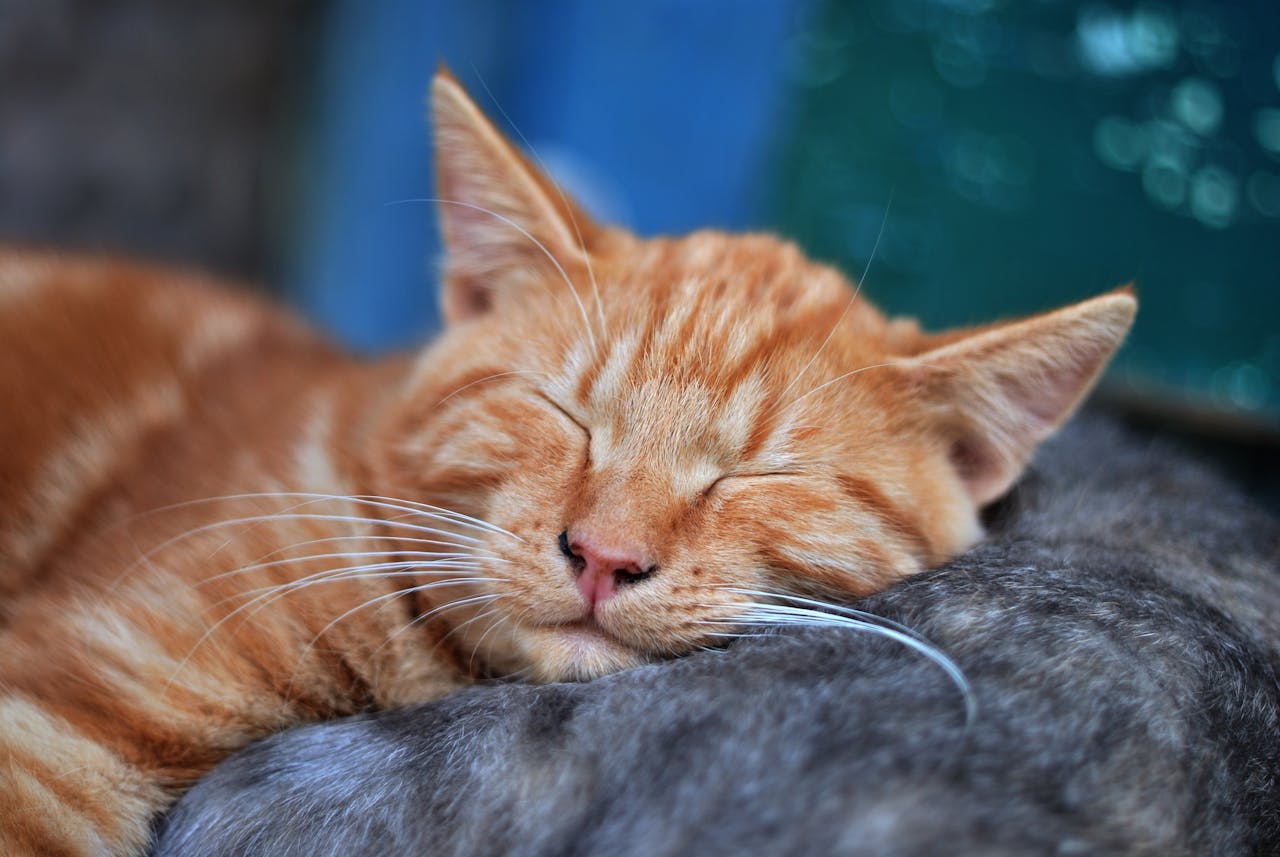Yes, cats definitely sleep more in winter! As the days get shorter and the temperatures drop, many cats turn into cozy little nap champions, curling up by the heater or basking in the last bit of sunlight. Learn why your cat is napping more this winter and how you can help them enjoy their cozy downtime even more!
Understanding Cat Sleep Patterns
Normal Sleeping Habits
Cats are natural polyphasic sleepers, meaning they nap in multiple short bursts throughout the day and night. This sleep pattern helps them stay rested without missing out on any opportunities for play or hunting, even if they’re indoor cats.
Domestic cats typically sleep between 12 to 16 hours a day, with some, particularly kittens and seniors, snoozing even more. Young and active cats may not sleep as much, but they still enjoy frequent naps because they are simply making the most of their rest to remain agile and alert when needed.
Circadian Rhythms
Circadian rhythms are the internal clocks that regulate sleep-wake cycles in both humans and animals, including cats. In winter, the shorter days and reduced sunlight cause cats’ internal clocks to signal that it's time to sleep more.
Cats are crepuscular animals, meaning they are most active during the dawn and dusk hours. However, when daylight is limited in winter, they adjust their patterns to get more sleep during the day, conserving energy for the quieter, darker hours.
This instinctual response helps them survive in the wild and is still evident in our pampered pets today, who enjoy their cozy naps in warm, sunlit spots when the days are shorter.
Winter Sleep Patterns in Cats
Research shows that a significant percentage of pet owners notice changes in their cats' behavior during the winter months. According to a 2020 study by the American Animal Hospital Association (AAHA), approximately 60% of pet owners reported that their cats sleep more as the days shorten and the temperature drops.
Similarly, a report from the American Veterinary Medical Association (AVMA) highlights that environmental factors, such as reduced daylight and cooler temperatures, can influence a cat's sleep patterns, leading to longer periods of rest.
These findings highlight the natural changes in your cat's behavior as they adapt to the colder months, seeking out warmer, cozier spots to rest.
Temperature Regulation
Cats are experts at staying cozy, and during the winter, sleeping more helps them conserve energy and stay warm. You’ll often find them tucked into tight spaces, wrapped in blankets, or curled up near heaters. These instinctual behaviors are all about maintaining the perfect body temperature while embracing their love for comfort.
Energy Conservation
Even though domestic cats don’t need to hibernate like some wild animals, their evolutionary instincts drive them to save energy during colder months. By sleeping more, they mimic behaviors designed for survival, even if their food bowl is always full. This natural inclination explains their wintertime tendency to nap the day away.
Why Do Cats Sleep More in Winter?
Biological Instincts
Even as pampered indoor pets, cats retain survival instincts from their wild ancestors. In the wild, conserving energy during colder months was crucial, and domestic cats still follow these patterns to some degree.
Seasonal Affective Disorder (SAD)
Just like humans, cats might experience mood changes due to reduced sunlight. While research on feline SAD is limited, it’s possible that seasonal shifts affect their mood-regulating hormones, making them a little sleepier or less playful.
Quality of Sleep
Colder temperatures can disrupt REM cycles, leading to lighter, more frequent naps. Providing a warm and cozy sleep environment helps ensure they get the deep rest they need.
Supporting Your Cat During Winter
Creating a Comfortable Environment
-
Offer blankets, cat beds, or heated pads for added warmth.
-
Place their favorite beds or blankets in sunny spots or near safe heat sources.
Encouraging Activity
-
Schedule interactive play sessions to keep them active.
-
Use puzzle feeders or treat-dispensing toys to engage their minds.
Monitoring Health
-
Keep an eye out for unusual lethargy or behavioral changes.
-
Schedule regular vet check-ups to rule out underlying health issues.
Using a Cat Nap Tracker
Keeping tabs on your cat’s sleep can reveal a lot about their overall health and happiness. Create a simple log or use a pet-tracking app to:
-
Note duration of naps, any increases or changes in their sleeping patterns.
-
Track how often they wake up and what seems to disturb them.
-
Record any shifts in mood or energy levels and behavioral changes.
By keeping track, you can ensure your furry friend is thriving during the colder months and address any concerns with your vet.
Is Your Cat a Winter Snoozer?
Take this fun quiz to discover your cat’s winter sleep personality and get tips for their seasonal comfort!
| Quiz Question | Your Cat's Answer |
|---|---|
| How Often Does Your Cat Nap? | A: All day, every day it’s like they’ve joined a sleep marathon. B: A bit more than usual, but not too noticeable. C: No change, they’re always on the go. |
| Where Are Their Favorite Nap Spots? | A: Snuggled in a blanket or near a heater. B: The usual spots, like a sunny windowsill. C: They’re too busy exploring to settle down. |
| How Active Is Your Cat in Winter? | A: They’ve turned into a furry couch potato. B: They’re playful but prefer indoor fun. C: Still zooming around the house like it’s summer. |
| Have You Noticed Changes in Appetite or Mood? | A: Eating and snoozing more, but they’re happy. B: A slight shift in appetite, but they seem content. C: Same appetite, same mood no changes at all. |
| What’s Your Cat’s Reaction to Colder Temperatures? | A: They burrow under blankets and refuse to leave. B: They stick close to warm spots but still wander. C: They seem unbothered and carry on as usual. |
| What’s Your Cat’s Winter Personality? | |
|---|---|
| Mostly A’s | Your cat is a Winter Snooze Champion! They’re embracing the cold months by maximizing their naps. |
| Mostly B’s | Your feline is a Seasonal Snoozer. They’re adjusting their habits slightly for winter, but it’s nothing dramatic. |
| Mostly C’s | Your kitty is a Perpetual Pouncer. Winter doesn’t seem to slow them down at all! |
Your Personalized Winter Tips
Winter Snooze Champion Cats
Create the ultimate nap haven with heated pads, soft blankets, and warm, sunny spots. They’ll appreciate the cozy touches as they drift into dreamland.
Seasonal Snoozers
Keep a balance between comfort and play. Offer toys that encourage activity while maintaining cozy spaces for downtime.
Perpetual Pouncers
Active felines might need extra stimulation with engaging toys or obstacle courses to burn off energy indoors during chilly weather.
Here’s a TikTok of a cat that absolutely refuses to wake up. Sleeping beauty vibes, anyone?
@may22818 Didn’t have the heart o disturb her 😻 #cutecat #cutekitten #catsoftiktok #cat #sleepycat #fypシ゚viral #foryou ♬ Love You So - The King Khan & BBQ Show
Supporting Your Cat's Seasonal Naps
As winter sets in, your cat’s love for naps becomes even more pronounced, and that’s perfectly normal. By understanding their sleep patterns and providing the right comfort, you can help them thrive during the colder months.
Celebrate your cat’s cozy winter moments with a custom pet portrait from West and Willow. A personalized piece of art is a perfect way to capture their unique charm and commemorate their seasonal downtime!
FAQs
Why do cats sleep more in winter?
Cats sleep more during winter due to a combination of shorter days, cooler temperatures, and their natural instincts to conserve energy and stay warm. The reduced sunlight can also impact their circadian rhythms, signaling their body to rest more.
Is it normal for my cat to sleep up to 20 hours in winter?
Yes, it’s normal! Cats are polyphasic sleepers, meaning they nap throughout the day and night. During winter, they may sleep more as they adapt to the changing light and temperatures.
How can I help my cat enjoy their winter naps?
To support your cat’s winter sleep, create a cozy environment with blankets, heated pads, or cat beds in sunny spots. You can also schedule playtime to keep them active when they’re awake.
Can cats experience Seasonal Affective Disorder (SAD)?
While research on feline SAD is limited, it’s possible that the reduced sunlight in winter could affect your cat’s mood, making them sleepier or less playful. Monitor their behavior and ensure they have a warm, comfortable environment.
How can I track my cat's winter sleep patterns?
Use a simple log or pet-tracking app to monitor your cat’s naps, noting any changes in sleep duration or patterns. Keeping track of their behavior helps ensure they stay healthy and happy during the colder months.


